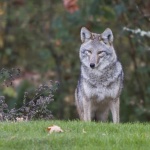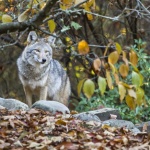Coyotes in Broadview…Best to keep an eye out on your pets.
Neighbors spotted a coyote in their yard. It had a large grey cat cornered and was about to move in for the kill. We opened our back door and scared it away giving the cat a chance to escape. The coyote returned a few minutes later looking for the cat. .
Aaron, Federal wildlife agent came out to West Seattle and did a talk on coyotes. “Don’t put your pets in harm’s way. And don’t make any other food source easily available, either. Losing pets to coyotes (or other predators) is a neighborhood problem, not a coyote problem.
He says one big problem is people letting their dogs out, unaccompanied, to relieve themselves in the middle of the night. Even if they’re just sticking to their own yards – a coyote might be out there, “coaxing” the dog to the edge of the yard because the dog gets “riled up” and wants to protect his yard, and that’s when they’ll get snatched. And he says letting cats roam outdoors is problematic too.
“A lot of these (coyote) ‘issues’ aren’t really issues if you (keep pets indoors),” he says, adding that while sometimes the coyote “situation” is “more serious than (residents) think … in this case, we’re just calming people down. It happens, it’s normal. This is not something that’s worth a coyote being euthanize– as of right now. … People just need to be reminded that their pets are precious and coyotes are out there. It’s natural. Try to keep (your pets) indoors.”
And watch out for other food sources, he advised – bird feeders can attract rodents, which coyotes eat (they might eat the seeds and nuts, too); even an uncovered compost pile can draw coyotes interested in food or produce scraps.
He says, “Just having us out there doesn’t mean we’re going to remove (coyotes),” and insists part of Wildlife Services’ job is “educating people and their cats and dogs.
So, what to do if you see a coyote?
Same advice we’re been sharing in coyote-sighting stories here for five years. “Yell at it, throw something.” Scare it away, so it maintains a healthy fear of humans. You’ll find that advice in this state publication, too. Overall, Aaron insisted, the state of things right now is not a coyote problem, but a neighborhood problem, and if neighborhoods minimize the food sources, the problem should recede.
link to West Seattle Blog article


